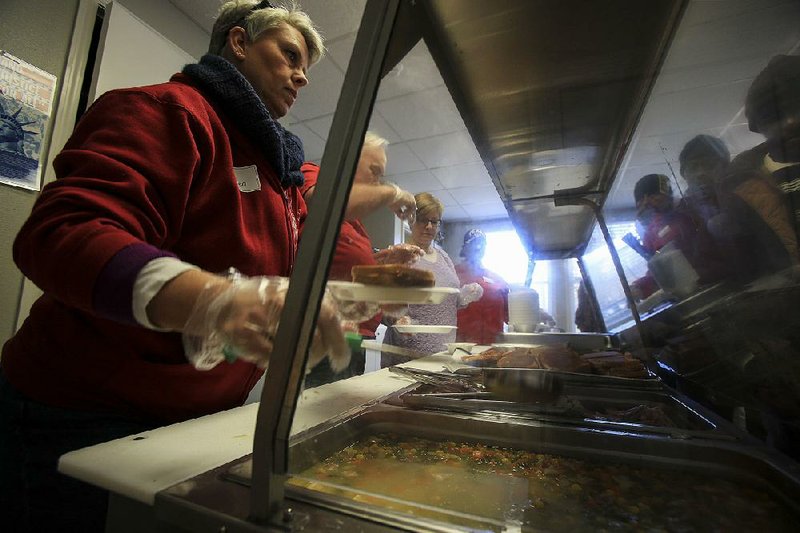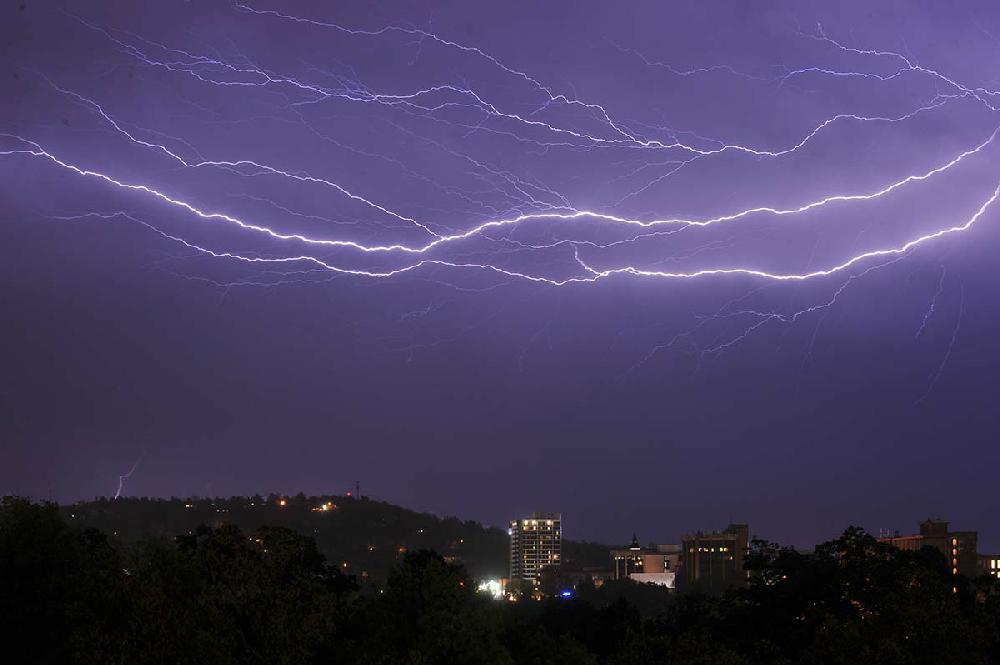A combination of icy conditions and bitter wind chills kept residents throughout Arkansas and neighboring states indoors - placing record burdens on some energy suppliers and overwhelming others.
Temperatures in central Arkansas dipped to a low of 10 degrees with a wind chill of 4 degrees Sunday night, sending hundreds to local warming stations and knocking out power - and heat - to more than 3,000 in Garland County. Central Arkansas has not seen temperatures that low since 1996.
The low temperatures caused residents to crank up their thermostats, causing an Entergy transformer at Hot Springs Village to trip, said Entergy spokesman Sally Graham.
“We’re not Minnesota, so we’re not built for that extreme cold,” Graham said. She added that the system performed exactly as it should have when the demand over-whelms the capacity of the power station.
Entergy technicians are rerouting electricity demands and monitoring load levels. As of 2 p.m. Monday, 2,300 were still without power.
Nancy Plagge, a spokesman for the Carroll Electric Cooperative, said loads on the cooperative’s power-production system reached a winter peak of 475.7 megawatts Monday at 8 a.m. Although demand had dropped to 415.3 megawatts by 1 p.m., even that exceeded the system’s summer peak of 413 megawatts on July 10, 2013. The demand has also far outstripped last year’s winter peak of 366 megawatts on Jan. 14, 2013.
Carroll Electric serves about 90,400 customers in seven counties throughout Northwest Arkansas, as well as Barry, McDonald, Stone and Taney counties in Missouri, Plagge said.
Southwestern Electric Power Co. spokesman Peter Main said same-day load figures for his company weren’t available but that it was possible the utility was looking at a new winter peak load. SWEPCO’s current winter peak load of more than 4,800 megawatts was measured at 8 a.m., Feb. 2, 2011. Main said the utility serves about 500,000 customers in Arkansas, Texas and Louisiana.
Wind chill is a calculation that describes the combined effect of the wind and cold temperatures on exposed skin.
Mike Teague, a meteorologist at the National Weather Service’s station in Tulsa, said wind chill is only measured on “animate objects” such as people and animals.
“It has no effect on your car or your trees or your house,” Teague said.
“There are a variety of effects that start to build up, though, like hypothermia and frostbite,” Teague said. “A lot of people don’t factor that in sometimes, how dangerous that can be. We just don’t see that kind of wind chill down here that often.”
Although Teague said the service doesn’t maintain data specifically on wind chill, average winds of 10-12 mph Sunday and Monday in Northwest Arkansas, combined with near-record low temperatures over night have created a stinging combination. The overnight low Monday in Fayetteville was minus 2. The lower recorded overnight low in Fayetteville for Jan. 6 was in 1970, when the temperature dropped to minus 3.
Other towns in Northwest Arkansas experienced even lower temperatures early Monday, with Winslow reaching minus 5 and Kingston recording minus 6.
Teague said that the cold front now battering most of the continental United States to one degree or another is the result of air streaming in from Alaska and the Yukon Territory of western Canada.
The Arkansas Dream Center, which partnered with Little Rock on Sunday to open a warming center at its Little Rock location, said they had about 102 people seek shelter from the cold Sunday night. More than 40 came in during the day Monday, and the center was expected to reach capacity of 150 overnight.
Center Executive Director Drew Davis said 90 percent of those served are among the homeless population in Little Rock while others are families or individuals who have lost heat at their homes.
More than 150 volunteers have flocked to the center since Sunday, helping to dole out hot meals, warm blankets, clothing and shoes and minor medical attention.
Davis said there is still a need for shoes, socks and coats to fill the needs presented by the extreme cold. The center is open 24 hours, and donations can be made at any time.
The Humane Society of Pulaski County said the freezing weather brought an influx of calls about animals being left in the cold without shelter or water.
Humane Society of Pulaski County Board President Christine Henderson warned of the dangers extreme cold places on pets.
“They will basically freeze to death if they can’t find shelter, and it is illegal to leave a dog without adequate shelter,” Henderson said.
The organization has even posted a link to Arkansas Code 5-62-103 on its Facebook page, asking residents to report neglect to their local law enforcement.
Road-maintenance crews throughout the state, but especially the northern counties, began work Monday morning knowing they had less than 10 hours to work with the most effective resource available to them in clearing ice-covered roadways: sunshine.
“Once the sun goes down, for lack of a better term, you’re just baby-sitting,” said Steve Lawrence, district engineer for the Arkansas Highway and Transportation Department’s 9th District. “When it’s this cold, you do more damage to your equipment than you do good on the roads.”
Lawrence said crews in his district, which covers eight counties along the western half of the state’s northern border, began working 12-hour shifts around the clock Saturday afternoon, when freezing precipitation began blowing across the northern half of the state. By Sunday morning, a layer of snow had covered much of Arkansas and several neighboring states.
Danny Straessle, a spokesman for the department in Little Rock, said temperatures in much of the state were so low Monday that compounds typically used to help melt ice, such as calcium chloride, had little to no effect. “Right now, the sun is our best friend,” Straessle said. “With temperatures as low as they are, especially at night, there’s no de-icing going on at all.”
While the extremely low temperatures are a first in recent memory for many Arkansans, it’s not the first major wave of winter weather to hit the area in the past few months. Heavy snow and ice covered much of Northwest Arkansas beginning Dec. 5, leaving roads in some areas impassable for as much as a week.
Monday, the Federal Emergency Management Agency announced that 13 Arkansas counties have been declared federal disaster areas because of the Dec. 5 winter storm. They were Crawford, Franklin, Johnson, Logan, Madison, Marion, Newton, Polk, Scott, Searcy, Sebastian, Sharp and Van Buren counties. The declaration means both hazard mitigation grants and public assistance grants will be available to repair or replace damaged roads and public facilities in those counties.
The frigid temperatures may also have also damaged or destroyed tree seedlings recently planted by Arkansas landowners for reforestation and conservation purposes, according to the Arkansas Forestry Commission. The planting season began on Jan. 1 and continues through March 31.
“The seedlings are newly planted, baby trees. They are not yet ready to withstand cold temperatures,” said Adriane Barnes, public information coordinator for the Arkansas Forestry Commission.
Those landowners who have picked up the seedlings from the state’s nurseries, but have not yet planted them are encouraged to wait until the temperature reaches between 35 and 60 degrees.
“You want to keep the storage time short, but leave them packaged and placed where it will not get below freezing until the temperature warms up and the wind dies down,” said Barnes.
School districts throughout northern Arkansas and Missouri were closed Monday. In Joplin, district administrators delayed the opening of three new schools built to replace schools destroyed in the EF5 tornado that devastated the city in May 2011.
According to data from the Arkansas Department of Health, hospital admissions due to cold-related illnesses and injuries across the state typically peak in December or January each year. Between January 2008 and December 2012, the most recent year for which data were available, Arkansas averaged 216 cold-related hospital admissions each year, with a peak of 45 such admissions in January 2010.
Kerry Krell, a department spokesman, said most of the illnesses were hypothermia or frostbite.
Dr. Shane Holland, director of the emergency department at Mercy Hospital Northwest Arkansas in Rogers, said that while frostbite and its precursor, frost nip, are rare in Arkansas, individuals should take precautions in the current weather by covering extremities such as fingers, toes, ears and noses whenever they are outside.
“People don’t realize how quickly they can be affected,” Holland said. “Their feet will numb, and they don’t realize they’re getting colder and colder. If they’re wet, they’re much more susceptible to thermal injuries. They can risk tissue damage, and can even require an amputation.”
Holland said that if an individual thinks they may be suffering from frostbite, they should first get indoors. Exposed areas should be treated with warm water, not hotter than 104 degrees Fahrenheit, Holland said.
Chris Buonanno, a meteorologist with the National Weather Service in North Little Rock, said temperatures will warm up in central Arkansas to the low 40s Tuesday. By Wednesday night, however, freezing rain is predicted for the state.
Front Section, Pages 1 on 01/07/2014

